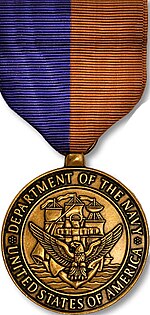Navy Meritorious Public Service Award
| Navy Meritorious Public Service Award | |
|---|---|
 Medal of the award | |
| Type | Civil decoration |
| Awarded for | Significant contributions with substantial impact upon a specific activity or geographical location |
| Country | |
| Presented by | Echelon II level commanders or higher |
| Eligibility | Private citizens not employed by the Department of the Navy |
| Status | Active |
Ribbon bar of the award | |
| Precedence | |
| Next (higher) | Navy Superior Public Service Award |
| Next (lower) | Navy Award of Merit for Group Achievement |
| Related | Navy Meritorious Civilian Service Award |
The Navy Meritorious Public Service Award is the third highest award that the United States Department of the Navy can present to private civilians not employed by the department. Like the other Navy Public Service Awards, it is generally awarded to business and civic leaders, scientists and other civilians who have made outstanding voluntary contributions to the mission and best interests of the Department of the Navy. It recognizes significant contributions with substantial impact upon a specific activity or geographical location. This award may be bestowed upon civilians by all Echelon I and II commanders, or above; and, is in rare cases signed and approved by the Secretary of the Navy.
Design
[edit]The medal, designed by the United States Mint, is bronze in color. The obverse has the Seal of the Department of the Navy, encircled by the inscription above "DEPARTMENT OF THE NAVY" and below, "UNITED STATES OF AMERICA." The reverse has the words "Awarded to" with a blank tablet for inscription of the recipient's name, resting on a spray of laurel. Arched at the top rim of the reverse of the medal is the word "MERITORIOUS." Horizontally, below the tablet, is the word "PUBLIC" and arched along the bottom rim is the word "SERVICE." The medal is suspended by a ribbon using divided in half vertically with blue on the left, and copper on the right.[1]
Recipients
[edit]
The award is available for private citizens and organizations who have performed outstanding voluntary contributions for the Department of the Navy, within the last five years.[2] The contributions must have had a significant and substantial impact upon a specific activity or geographical location. With the exception of senior Department officials in non-career or appointive positions, only individuals or groups who were not employed by the Department during the time of their contributions are eligible for selection.[2] Recipients of the award are presented with the full-size medal, in addition to a miniature medal, a mounted ribbon, and a lapel pin. Also included with the award is a certificate signed by the commanding officer authorizing the award.[2] Nominations for the award are considered by the Department's Board of Decorations and Medals.[3] This award is bestowable by all Echelon I and II commanders, or above; and is in rare cases is signed and approved by the Secretary of the Navy.[4] If the award was earned prior to entrance into the Naval Service, or while under a U.S. Navy Reserve contract during off-duty (civilian) hours, it may not be worn on the military uniform.[5]
Notable Recipients
[edit]Geophysicist J. Lamar Worzel received the award for his assistance in the April 1963 search and recovery of the USS Thresher, the world's first nuclear submarine lost at sea, which had sunk to a depth of 8,400 ft (2,600 m) around 350 km east of Cape Cod in the North Atlantic.[6][7] In 2011, Franklin R. Parker the 18th Assistant Secretary of the Navy for Manpower and Reserve Affairs, was bestowed with the award for his work in advising the General Counsel and Navy Secretariat on a range of legal issues impacting the Navy and its personnel.[8] Gerald A. Cann, the first Assistant Secretary of the Navy for Research, Development and Acquisition, was also a recipient of the award.[9]

See also
[edit]References
[edit]- ^ Decorations & Medals archive; The Institute of Heraldry. United States Department of Defense, The Pentagon
- ^ a b c Deputy Assistant Secretary of the Navy (Civilian Human Resources) (September 2005). "Guide No. 451-02 DEPARTMENT OF THE NAVY (DON) HUMAN RESOURCES IMPLEMENTATION GUIDANCE" (.PDF). United States Department of the Navy. p. 21. Retrieved 2015-06-17.
- ^ "Title 32, Volume 5, § 705.37". Code of Federal Regulations (txt). U.S. Government Printing Office. 1 July 2003. pp. 170–172. 32CFR705.37. Retrieved 17 June 2015.
- ^ Deputy Assistant Secretary of the Navy (Civilian Human Resources) (September 2005). "Guide No. 451-02 DEPARTMENT OF THE NAVY (DON) HUMAN RESOURCES IMPLEMENTATION GUIDANCE" (.PDF). United States Department of the Navy. pp. 28–29. Retrieved 2015-06-17.
- ^ Assistant Secretary of the Navy (Manpower and Reserve Affairs) (22 August 2006). "SECNAV INSTRUCTION 1650.1H; NAVY AND MARINE CORPS AWARDS MANUAL" (PDF). United States Department of the Navy. Retrieved 30 March 2017.
- ^ Maugh II, Thomas (2 February 2009). "J. Lamar Worzel dies at 89; Columbia University physicist". Los Angeles Times. Retrieved 30 March 2017.
- ^ Brand, V (1977). "Submersibles – Manned and Unmanned". South Pacific Underwater Medicine Society Journal. 7 (3). ISSN 0813-1988. OCLC 16986801. Archived from the original on August 1, 2008. Retrieved 10 July 2008.
{{cite journal}}: CS1 maint: unfit URL (link) - ^ "U.S. Navy Biographies — THE HONORABLE FRANKLIN R. PARKER". United States Department of the Navy. 14 January 2016. Retrieved 27 March 2017.
- ^ United States. Congress. House. Committee on Appropriations. Subcommittee on Dept. of Defense (1976). Department of Defense Appropriations for Fiscal Year 1977: Hearings Before a Subcommittee of the Committee on Appropriations, United States Senate, Ninety-fourth Congress, Second Session, on H.R. 14262. U.S. Government Printing Office. p. 285. ISBN 9780160356698.
External links
[edit]- This article incorporates text in the public domain from the United States Government.

